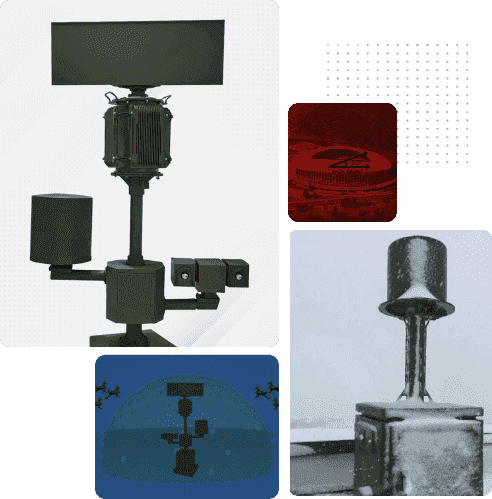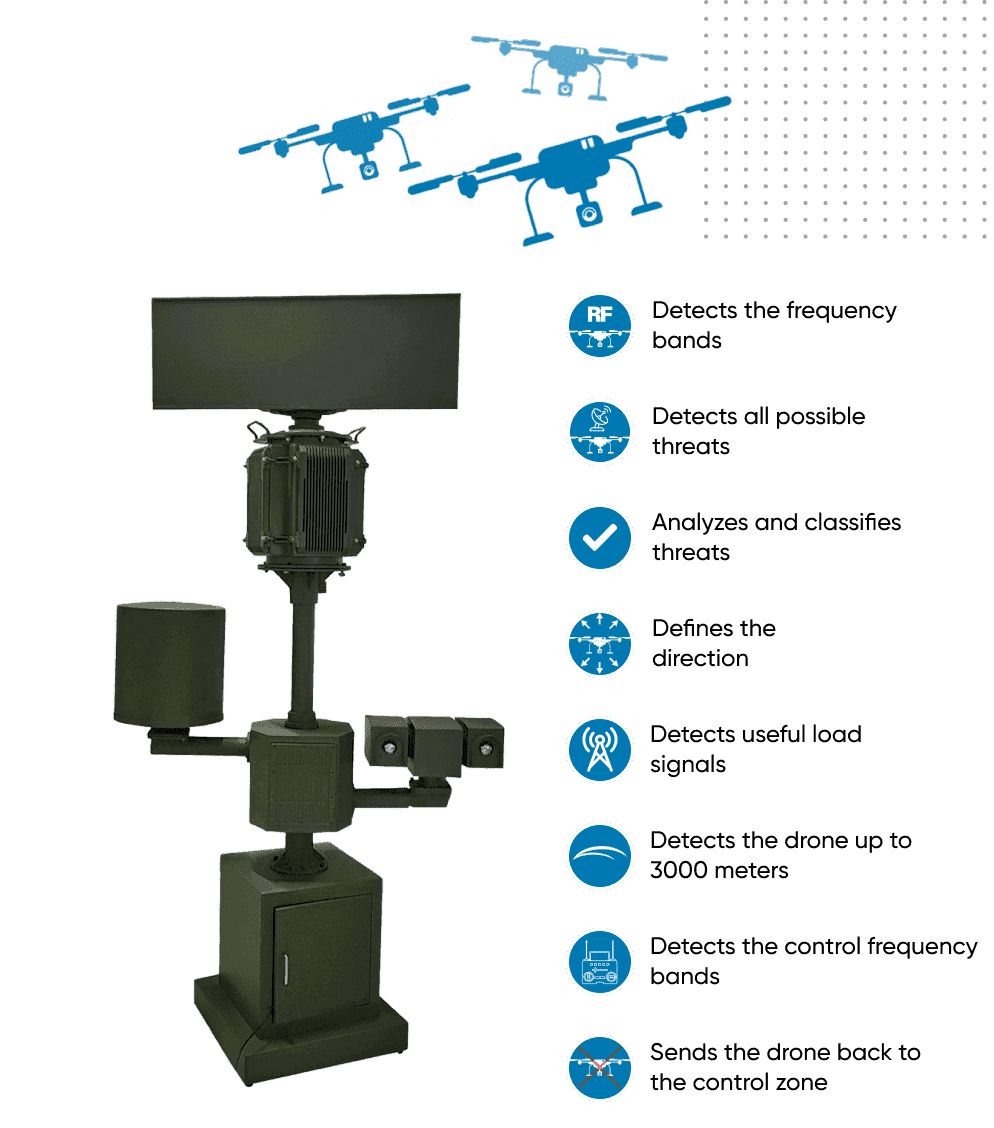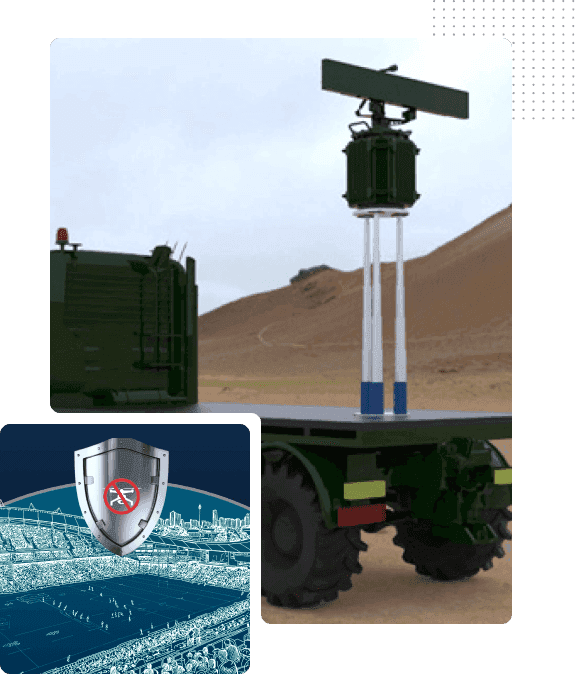SOLUTIONS
KUBBE
Strategic Facility Security Systems
Because of factors such as low cost, high speed, maneuverability, load-carrying capacity, the ability to create fear and chaos, maximum effect in achieving the goal and being risk-free for the organization that organizes the attack; drone and mini UAVs are widely used by hostile and terrorist organizations for an attack, espionage, harassment; and drone attacks become a strikingly growing global threat.

Detects low RCS targets with remarkable range performance which is very important in today’s threat environment. It is powered by a solid state transmitter and is driven by user-friendly open architeAs concerns about potential security threats increase, anti-drone systems developed with new generation technologies are rapidly becoming worldwide.
The number of countries concentrating on developing tools and methods of monitoring and passivating unmanned aerial vehicles is increasing rapidly with each passing day. It is known that there are more than 200 different anti-drone systems developed in recent years and about 40% of them can only be used for detection, 35% only for prevention, and 25% for simultaneous detection, tracking and prevention.
The fact that countries have significantly increased the amount they allocate for creating opportunities and capabilities that will resist unmanned systems in their defense budgets shows that the anti-UAV systems are the fastest growing trend related to unmanned systems in defense spending in recent years.
Anti-drone systems utilize various technologies in detecting and tracking drones and mini UAVs, and these capabilities can be used alone or together to be more effective. In existing detection, classification and tracking systems; radar, radio frequency (RF), electro-optic (EO), infrared (IR) and acoustic sensor methods can be used. One of the most common methods is radar systems. In radar systems, algorithmic techniques can also be used to distinguish UAVs from other weather elements and birds.


By scanning the frequency ranges of drone and mini UAVs by radio frequency (RF), it is possible to detect the threatening elements. Electro-optic (EO) sensors enable imaging, acoustic sensors capture sound, and infrared sensors allow detection of the drone or mini UAV by capturing heat dissipation. These techniques are not effective in detecting and monitoring all threatening elements when used alone. That’s why today’s systems are using these methods by combining them.
On the other hand, different techniques can be used together to eliminate the detected unmanned aerial systems threats. These techniques are often; functional destruction (soft kill) (Jamming and spoofing) and physical destruction (hard kill) (bullet, network and laser) capabilities. The jamming method makes drone or mini UAV return to land on the ground, return to the departure point, or continue their flight by disrupting the radiofrequency or satellite communication signals, and interrupting the image transfer. Spoofing, on the other hand, is the technique of capturing the control or satellite connections of threat elements.
The prominent methods in counteracting drones and mini UAVs by physical destruction capabilities are bullets, network and laser systems. Conventional weapons that can be used widely are considered as an important option to equip anti-drone systems.
Systems that neutralize threat elements with nets are also one of the techniques currently used. In addition, laser (directed energy weapons) weapons is a very effective method used against light, slow and low altitude drones and mini UAVs.
Strategic Facility Security Systems
A Dynamic Defense Against Enemy Drones with “KUBBE”
RST develops powerful, ready-to-use, end-to-end solutions to protect critical bases and zones defined as strategic facilities such as government borders, power plants, oil pipelines, military bases, and airports against drone and mini UAV threats.
While the KUBBE Anti-Drone System ooffers superior drone detection and tracking performance with its radar system and optional thermal / optical cameras, it also allows the drone and mini UAV threats to be neutralized with the optional RF mixer. In the KUBBE Anti-Drone System, in order to create the most effective solution against threats, according to on-site inspections; different configurations and sensor types can be integrated according to the purpose. On the other hand, if necessary, these different sensors and countermeasures can be integrated together in positions such as on the vehicle.

KUBBE
Technical Specifications
| Operating Frequency Band | X-Band |
|
Detection (%80 Pd and 10-6 Pfa) |
Human: > 15 km Big vehicle: >28 km UAV (RCS=0,01 m2 ): >6 km Helicopter: >25 km |
| Velocity Detection | 0,2 – 100 m/s |
| Elevation Beamwidth | -5° to 50° |
ACCURACY
| Azimuth | ≤ 1° (RMS) |
| Range | ≤ 10 m (RMS) |
| Elevation | ≤ 1° (RMS) |
| Velocity | ≤ 0,8 m/s |
| Azimuth Coverage | 360º |
| Scanning Rate | Adjustable up to 180°/sec |
| Weight | ≤ 90 kg |
| Dimensions | 110 x 400 x 900 mM |
| Operational Readiness | ≤ 10 miN |
| Operational Temperature | -40 – +60 °C |
| Storage Temperature | -50 – +70 °C |
| MTBF | 5000 hours |
RESOLUTION
| Elevation | ≤ 2° (RMS) |
| Azimuth | ≤ 2° (RMS) |
| Range | 15m |


